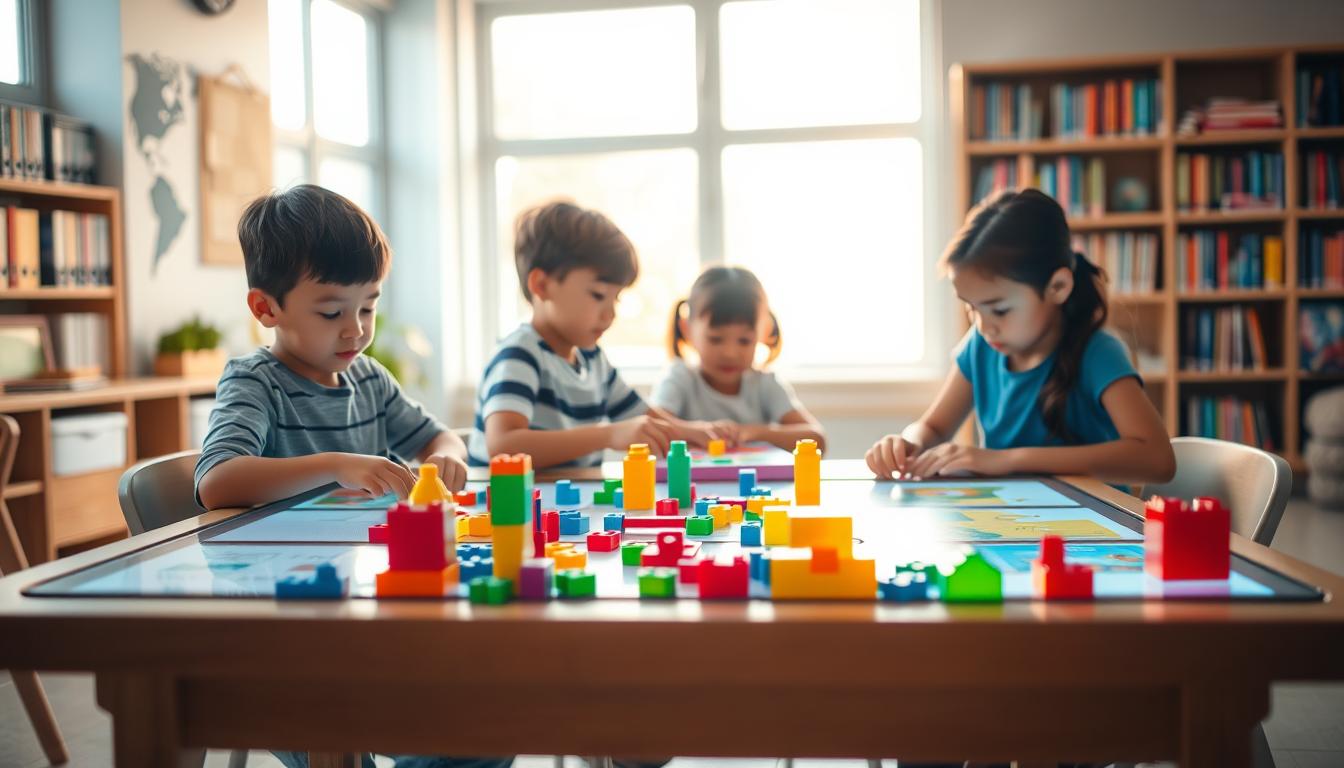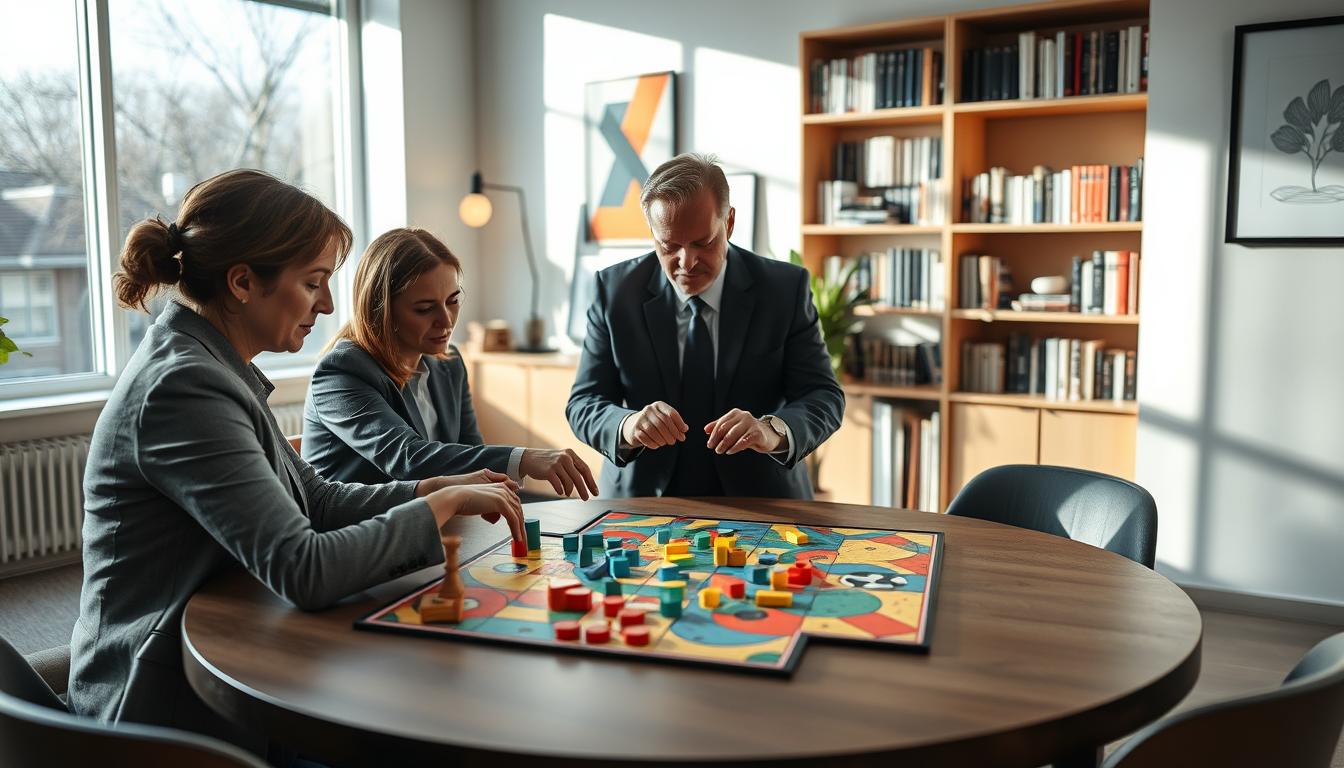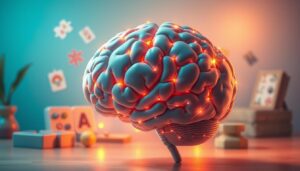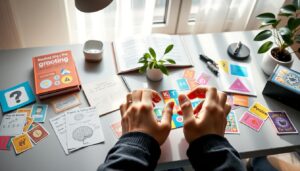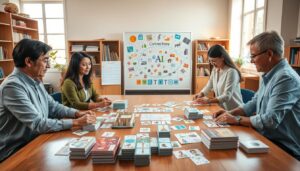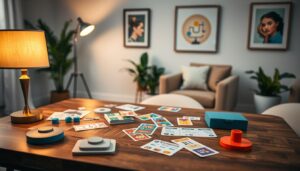Educational games that help process large amounts of information efficiently
Ever thought a game could change how we learn? In today’s world, where we’re bombarded with info, educational games are key. They make learning fun and boost our brain power. This makes it simpler to remember and use what we learn.
By playing brain games, we can handle the flood of information better. This leads to better memory and using what we learn in real life.
The Importance of Educational Games in Today’s Learning Environment
Educational games are now seen as key in today’s learning world. They help make learning fun and engaging. This makes students enjoy learning and understand it better.
Using games in learning fits with today’s tech trends. Students love these interactive ways to learn. Studies show it can make students do better in school, helping both students and teachers.
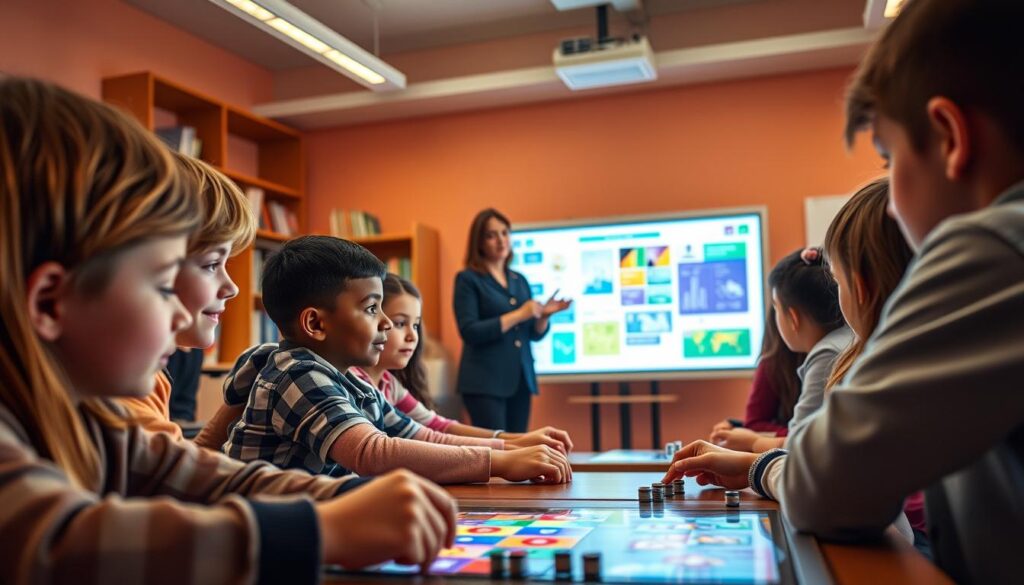
By focusing on educational games, schools can make learning exciting. These games help students remember what they learn. Making learning fun is key to keeping students interested and motivated.
Understanding Gamification in Education
Gamification is a powerful tool in education. It uses game mechanics to motivate students and improve learning strategies. By adding elements like points, leaderboards, and badges, educators create an engaging classroom.
This approach changes how we learn, making it more fun. Students work together and solve problems better. They become more interested in their studies because of the game-like nature.
Gamification works well in many subjects. Students get excited about learning math or language arts when they see their progress. It makes them feel accomplished and motivated.
Teachers see the benefits of gamification in their classrooms. It helps students understand better and keeps them interested in learning. Gamification makes learning fun and helps students succeed.
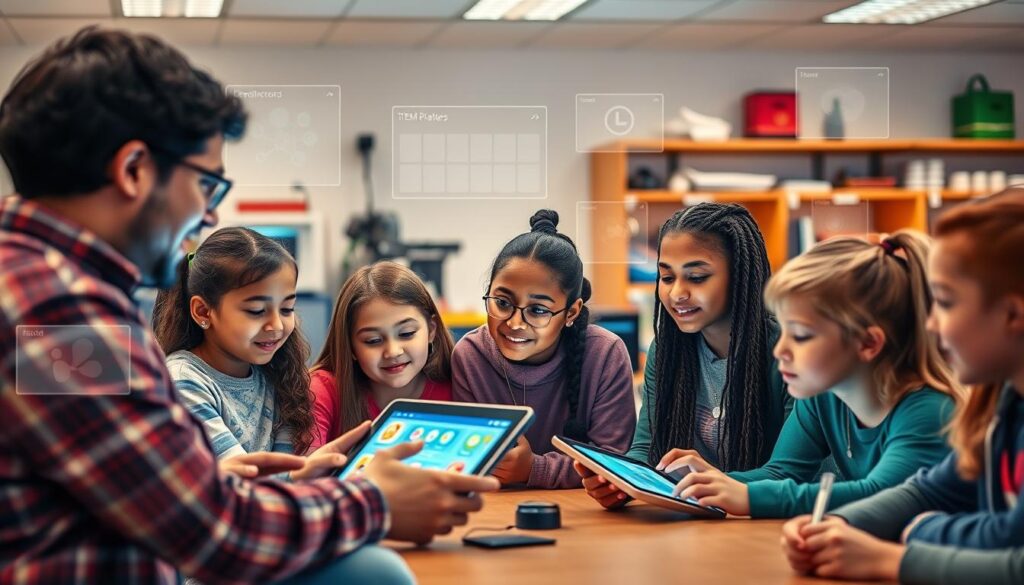
The Neuroscience Behind Educational Games
Educational games use the neuroscience of learning to help our brains learn better. They focus on areas like the hippocampus, which is key for remembering things. This makes learning more effective and fun.
Games also have a special effect on our brains. They release dopamine, which makes us feel good and want to learn more. This makes learning a fun, rewarding experience.
Storytelling in games adds to the fun and helps our brains learn faster. It mixes fun tasks with stories, making learning easier and more enjoyable. This is important for how our brains and education work together.
How Educational Games Enhance Cognitive Skills
Educational games are a great way to boost cognitive skills for people of all ages. They make learning fun by improving critical thinking, problem-solving, and memory. These games create a lively space where learning grows.
Playing games helps a lot with thinking skills. Players face tough puzzles and must make quick decisions. This makes them think deeply and solve problems in new ways. It’s like a workout for the brain that helps with learning later on.
Memory games are also a big plus. They help players remember things better. Games use tricks like repeating information to help keep it in mind. This is especially good for kids who are still learning.
Also, educational games help the brain change and grow. Players face different challenges and stories, which makes their brains more flexible. This is especially important for kids, who can learn and grow fast.
Brain Games for Managing Information Overload
The modern learner often faces a lot of information. This can make it hard to remember things well. Brain games are a great way to deal with this. They help process information better and improve memory through fun activities.
These games use retention strategies to make it easier to handle lots of data. They help clear the mind and avoid feeling overwhelmed.
How Brain Games Improve Retention
Playing brain games makes different parts of the brain work better. This boosts memory. Players do tasks that need focus and quick thinking, which strengthens memory paths.
These games also encourage learning through repetition. This helps users remember new things better. Regular play can greatly increase memory, helping to manage information overload.
Emotional Engagement and Memory
Emotions in brain games are key to remembering what you learn. When you care about what you’re doing, you’re more likely to remember it. Games often have stories or characters that make you feel something.
This emotional connection makes learning more meaningful. It helps you use what you learn in real life. It’s a powerful way to fight cognitive overload and improve learning.
Popular Educational Game Platforms
Many educational game platforms are changing how we learn. They use fun games to make learning better. This makes learning more fun and helps us remember things better.
Khan Academy: A Model for Gamified Learning
Khan Academy is a great example of this. It makes learning fun and easy. Students get to do interactive exercises and see how they’re doing.
It uses points and badges to keep students motivated. This helps them dive deeper into their studies.
Quizlet: Transforming Study Habits
Quizlet has changed how we study with its game-like features. It lets users make flashcards and quizzes. This helps them remember important stuff.
It also has features like study streaks and leaderboards. These make studying a fun competition. It encourages students to work together and learn from each other.
Integrating Game Elements into Traditional Learning
Adding games to education can really boost student interest and drive. Teachers looking to mix games into their lessons can use many ways to make learning fun. For example, using points can push students to reach goals. Challenges can also help improve problem-solving and teamwork.
Using badges as rewards is another smart move. It shows students’ hard work and sparks friendly competition. This makes learning a fun and engaging experience for everyone.
Teachers should carefully add these game elements to avoid overwhelming students. Starting slow helps students get used to the new approach. This careful method keeps students motivated and involved in their learning.
Examples of Effective Educational Games
Engaging students is key, and games are a big help. They make learning fun and interactive. Here are two examples of games that make learning exciting.
Duolingo: Language Learning through Gamification
Duolingo makes learning languages fun. It uses points, levels, and rewards to keep users interested. This makes learning a game, not a chore.
Kahoot!: Creating a Fun Learning Environment
Kahoot! is all about making classrooms fun. Teachers create quizzes that students play on their devices. It’s a way to make learning a team effort, making it more enjoyable.
Using AI and Technology to Enhance Learning Games
AI in education is changing how students interact with learning materials. It makes learning games more personal with the help of new tools. These tools use smart algorithms to adjust to each student’s needs.
These algorithms check how well students do and give feedback right away. They also offer challenges that fit each student’s learning style. This keeps students engaged and helps them learn better.
Machine learning helps find out what each learner is good at and what they need to work on. This lets educational games change their level of difficulty. It makes sure students are challenged but not too hard to handle.
As students get better, the AI makes the game even more interesting. This keeps students interested and helps them remember what they’ve learned.
AI also makes learning more interactive by helping students work together online. This creates a sense of community in learning. It’s a big step forward in how we learn together.
The future of educational games looks bright with AI and technology leading the way. Together, they create learning environments that are fun, dynamic, and meet the needs of all students.
Creating Custom Educational Games with Apps
The world of education is changing fast with custom educational games. These tools make learning fun and personal. Teachers can create games that fit each student’s needs and interests.
These games can teach many subjects. This means every student gets a learning experience that’s just right for them. The games are made in a way that makes learning exciting and easy to understand.
One great thing about these apps is how they can be changed. Teachers can update the content, make the games harder or easier, and add feedback. This helps students learn better and stay interested.
As technology gets better, so will custom educational games. These tools make learning fun and help students learn in their own way. They create a space where every student can grow and learn.
Benefits of Gamification in Homework and Revision
Gamification in homework makes studying fun and interactive. It adds game elements to assignments, boosting student motivation. This way, homework becomes something students look forward to, leading to better understanding and memory.
Engaging Students Outside the Classroom
Gamification turns revision into a fun activity. It uses points, achievements, and challenges to keep students engaged. Students feel a sense of achievement as they track their progress, which motivates them to learn more.
Studies show that gamified homework improves retention and grades. It also promotes teamwork. Students work together, solving problems and competing in friendly challenges. This teamwork not only helps in learning but also builds a strong classroom community.
Challenges in Implementing Educational Games
Using games in education can face many hurdles. One big problem is the technology issues teachers might have. Not having enough devices, slow internet, or old computers can stop games from being used widely.
Another challenge is getting students to play along. Not all students like playing games in class. Teachers must find ways to make games interesting for everyone.
Teachers also need training to use games well. They should get help and learn how to use games effectively. Without training, teachers might not use games as well, which can hurt student learning.
Conclusion
Looking back at our journey through educational games, we see how gamification changes learning. It makes learning fun and helps students understand complex topics better. This approach keeps students motivated and competitive, something traditional teaching often misses.
The future of learning is bright with more gamification in schools. Teachers should use these tools to keep students interested and handle information overload. Educational games create a lively learning space, leading to better grades and a more prepared generation.
In the end, our review shows that education needs to be flexible and creative. As we go forward, using gamification wisely will be key. It will help make learning fun, effective, and relevant for students everywhere.
FAQ
What are educational games and how do they aid in processing information?
Educational games are tools that make learning fun. They help improve how we think and handle lots of information. These games use game-like features to help us remember and stay interested in what we’re learning.
Why is gamification essential in today’s education?
Gamification makes learning fun by adding game-like elements. It meets today’s students’ love for technology. It also boosts teamwork, problem-solving, and interaction.
How do educational games affect memory retention and cognitive skills?
Educational games improve memory by making the brain work harder. They help us think better and solve problems. These games make learning fun and effective.
Can you explain the connection between neuroscience and educational games?
Neuroscience shows that games can make us more motivated. The stories in games help us remember better. This leads to better learning.
What are some popular platforms for educational games?
Sites like Khan Academy and Quizlet use games to teach. They offer points, badges, and challenges. This makes learning fun and competitive.
How can educators integrate gaming elements into traditional methods?
Teachers can use points, badges, and challenges to make learning fun. This makes students more engaged and motivated.
What are some examples of successful educational games?
Games like Duolingo and Kahoot! show how games can improve learning. They make learning fun and interactive.
How do AI and technology improve educational games?
AI and machine learning make games more personal. They adjust to each learner’s needs. This makes learning more effective and fun.
What are the benefits of creating custom educational games?
Custom games let teachers focus on specific subjects. They make learning creative and engaging. This leads to better learning outcomes.
How can gamification revolutionize homework and revision?
Adding games to homework keeps students motivated. It helps them study better and remember more. Learning becomes enjoyable.
What challenges do educators face when implementing educational games?
Teachers face tech issues, varying student interest, and training needs. Overcoming these helps make games effective learning tools.
